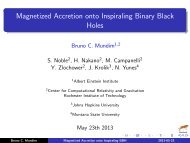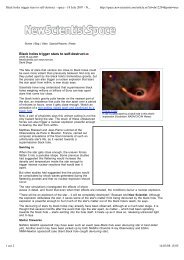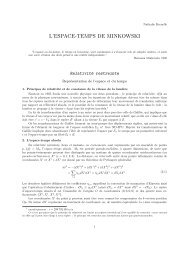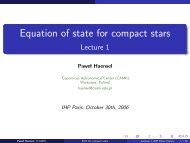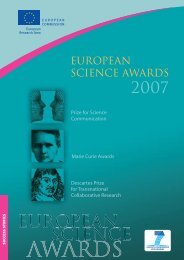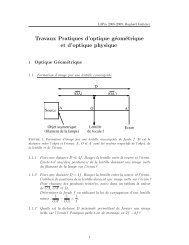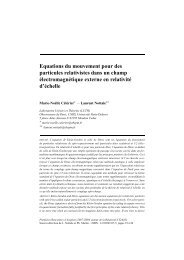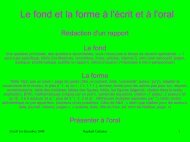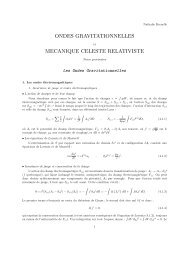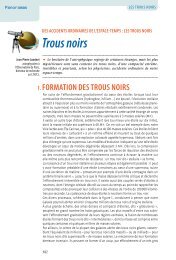J. Phys. A: Math. Gen. 32 (1999) - LUTH - Observatoire de Paris
J. Phys. A: Math. Gen. 32 (1999) - LUTH - Observatoire de Paris
J. Phys. A: Math. Gen. 32 (1999) - LUTH - Observatoire de Paris
You also want an ePaper? Increase the reach of your titles
YUMPU automatically turns print PDFs into web optimized ePapers that Google loves.
2874 J-C Pisson<strong>de</strong>s<br />
Now, the goal which we search is not to <strong>de</strong>scribe a given <strong>de</strong>terministic fractal trajectory,<br />
but instead to un<strong>de</strong>rstand the trajectories as being the geo<strong>de</strong>sics of a fractal space. Following<br />
[1, 2], we assume that the non-differentiability of space would imply that there will be an<br />
infinity of geo<strong>de</strong>sics coming in to any point and another infinity coming out from it. Two sets<br />
of geo<strong>de</strong>sics are introduced, assuming that the differential time reflection symmetry dt →−dt<br />
is broken by non-differentiability. Then we are led to replace the individual mean velocity vi by two velocity fields vi + {x(t),t} and vi− {x(t),t}.<br />
One of the important new features of scale relativity compared with similar approaches<br />
such as stochastic mechanics [13] consists of introducing a complex velocity field, which mixes<br />
the forward and the backward fields as [1]<br />
V i i v+ + v<br />
≡<br />
i i<br />
− v+ − v<br />
− i<br />
2<br />
i <br />
−<br />
≡ V<br />
2<br />
i − iU i .<br />
This choice is motivated by the constraint to recover a real field V and a vanishing imaginary<br />
field in the classical limit v+ = v−.<br />
The last step is to construct a ‘scale-covariant <strong>de</strong>rivative’, which <strong>de</strong>scribes the effects on<br />
physical quantities of the new geometric structure of space. The variation of a field f {x(t),t}<br />
during a time interval dt is given by df [1, 2], where<br />
d ∂<br />
= + V ·∇−icλ<br />
dt ∂t 2 <br />
in the special case when the fractal dimension is D = 2, which in<strong>de</strong>ed plays a critical role in<br />
such an approach [2, 4, 5, 11]. We are now able to write the equations of free motion ‘in fractal<br />
space’. One starts from the equations of geo<strong>de</strong>sics in Eucli<strong>de</strong>an space, i.e. the equations of<br />
inertial motion, dV /dt = 0 and one uses d/dt asa‘scale-covariant <strong>de</strong>rivative’. One obtains<br />
the free equations [1]<br />
dV ∂V<br />
= 0 ⇔ + V ·∇V−icλV<br />
= 0.<br />
dt ∂t 2<br />
We may also use the Euler–Lagrange equations. Given a complex Lagrange function in<br />
its usual form: L(x, V) = (1/2)mV2 , we write the Euler–Lagrange equations as in classical<br />
mechanics. We then obtain precisely the previous form, dV/dt = 0. The same can be said in<br />
both cases, in the presence of a potential φ(x). Our equations of motion then take the usual<br />
form of the Newton law: mdV/dt =−∇φand the corresponding Lagrange function becomes<br />
L(x, V) = (1/2)mV2 − φ.<br />
This equation can finally be transformed by introducing the wavefunction as another<br />
expression for the action, following the familiar ansatz<br />
ψ ≡ e iS/mcλ .<br />
Therefore, the complex velocity field is related to the wavefunction ψ by the relation<br />
V =−icλ∇(ln ψ). The replacement of V in the equations of motion with potential by this<br />
expression yields an equation which, once integrated, is the Schrödinger equation [1, 2]<br />
(cλ) 2<br />
2<br />
ψ +icλ∂ψ<br />
∂t<br />
φ<br />
− ψ = 0<br />
m<br />
with mcλ = ¯h.<br />
The Born interpretation of quantum mechanics would also be consistent with such an<br />
approach. A probability <strong>de</strong>nsity is <strong>de</strong>fined from the fluid of geo<strong>de</strong>sics, while the imaginary<br />
part of the geo<strong>de</strong>sic-Schrödinger equation writes ∂ρ/∂t + ∇·(ρV ) = 0, where ρ = ψψ † and<br />
where V is the real part of V. This is the continuity equation (which is now in this approach



